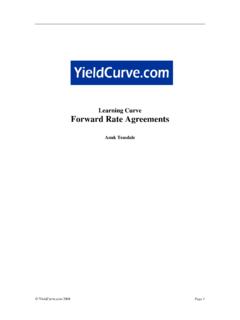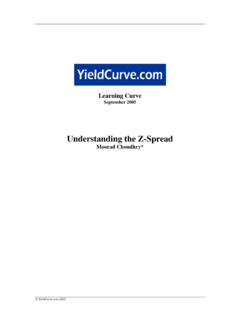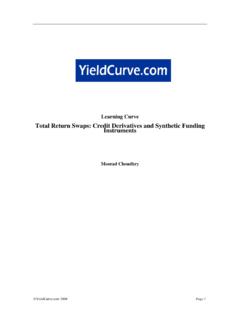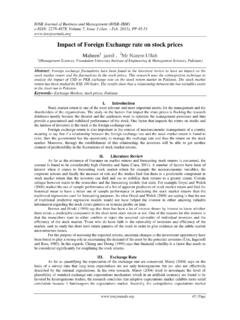Transcription of An introduction to Value-at-Risk
1 An introduction to Value-at-Risk Learning Curve September 2003 2 Value-at-Risk The introduction of Value-at-Risk (VaR) as an accepted methodology for quantifying market risk is part of the evolution of risk management. The application of VaR has been extended from its initial use in securities houses to commercial banks and corporates, and from market risk to credit risk, following its introduction in October 1994 when JP Morgan launched RiskMetrics . VaR is a measure of the worst expected loss that a firm may suffer over a period of time that has been specified by the user, under normal market conditions and a specified level of confidence.
2 This measure may be obtained in a number of ways, using a statistical model or by computer simulation. VaR is a measure of market risk. It is the maximum loss which can occur with X% confidence over a holding period of n days. VaR is the expected loss of a portfolio over a specified time period for a set level of probability. For example if a daily VaR is stated as 100,000 to a 95% level of confidence, this means that during the day there is a only a 5% chance that the loss the next day will be greater than 100,000.
3 VaR measures the potential loss in market value of a portfolio using estimated volatility and correlation. The correlation referred to is the correlation that exists between the market prices of different instruments in a bank s portfolio. VaR is calculated within a given confidence interval, typically 95% or 99%; it seeks to measure the possible losses from a position or portfolio under normal circumstances. The definition of normality is critical and is essentially a statistical concept that varies by firm and by risk management system.
4 Put simply however, the most commonly used VaR models assume that the prices of assets in the financial markets follow a normal distribution. To implement VaR, all of a firm s positions data must be gathered into one centralised database. Once this is complete the overall risk has to be calculated by aggregating the risks from individual instruments across the entire portfolio. The potential move in each instrument (that is, each risk factor) has to be inferred from past daily price movements over a given observation period.
5 For regulatory purposes this period is at least one year. Hence the data on which VaR estimates are based should capture all relevant daily market moves over the previous year. VaR is only a measure of a bank s risk exposure; it a tool for measuring market risk exposure. There is no one VaR number for a single portfolio, because different methodologies used for calculating VaR produce different results. The VaR number captures only those risks that can be measured in quantitative terms; it does not capture risk exposures such as operational risk, liquidity risk, regulatory risk or sovereign risk.
6 3 Assumption of normality A distribution is described as normal if there is a high probability that any observation form the population sample will have a value that is close to the mean, and a low probability of having a value that is far from the mean. The normal distribution curve is used by many VaR models, which assume that asset returns follow a normal pattern. A VaR model uses the normal curve to estimate the losses that an institution may suffer over a given time period. Normal distribution tables show the probability of a particular observation moving a certain distance from the mean.
7 If we look along a normal distribution table we see that at standard deviations, the probability is 5%; this means that there is a 5% probability that an observation will be at least standard deviations below the mean. This level is used in many VaR models. (We will present an introduction to standard deviation and the normal distribution in a later Learning Curve). Calculation methods There are three different methods for calculating VaR. They are: the variance/covariance (or correlation or parametric method); historical simulation; Monte Carlo simulation.
8 Variance-covariance method This method assumes the returns on risk factors are normally distributed, the correlations between risk factors are constant and the delta (or price sensitivity to changes in a risk factor) of each portfolio constituent is constant. using the correlation method, the volatility of each risk factor is extracted from the historical observation period. Historical data on investment returns is therefore required. The potential effect of each component of the portfolio on the overall portfolio value is then worked out from the component s delta (with respect to a particular risk factor) and that risk factor s volatility .
9 There are different methods of calculating the relevant risk factor volatilities and correlations. Two alternatives are: simple historic volatility : this is the most straightforward method but the effects of a large one-off market move can significantly distort volatilities over the required forecasting period. For example if using 30-day historic volatility , a market shock will stay in the volatility figure for 30 days until it drops out of the sample range and correspondingly causes a sharp drop in (historic) volatility 30 days after the event.
10 This is because each past observation is equally weighted in the volatility calculation; to weight past observations unequally: this is done to give more weight to recent observations so that large jumps in volatility are not caused by events that occurred some time ago. One method is to use exponentially-weighted moving averages. 4 Historical simulation method The historic simulation method for calculating VaR is the simplest and avoids some of the pitfalls of the correlation method.












